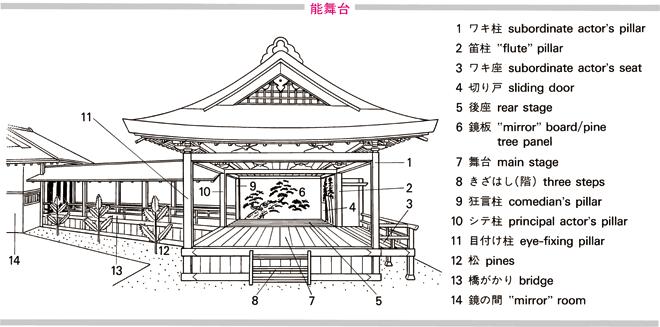プログレッシブ和英中辞典(第4版)の解説
のう【能】
人の上に立つ能がない
He has no ability to lead others.
あてがわれた仕事をするよりほかに能のない男だった
He could only do what he was told to do.
彼は何の能もない男だ
He has nothing to recommend him.
言葉を飾るだけが能ではない
It is not everything to talk in fine language.
❷〔効能〕
今さら古い議論を蒸し返しても能のないことだ
It's of no use to reopen old controversies now.
能書き
⇒のうがき(能書き)
❸〔能楽〕a Noh play [dance]
説明
Noh is a type of traditional Japanese musical drama and is one of the oldest surviving forms of stage art in the world. It was developed into its present form in the Muromachi era by Kan'ami and his son, Zeami. Noh theaters, called noh-gakudo, have a covered stage built of hinoki Japanese cypress, and open toward the audience in three directions. On this stage, the shite, or masked principal actor, sings and dances. The waki, or supporting actor, usually performs without a mask. The jiutaigata, or chorus, chant yokyoku Noh songs, and the hayasikata, or instrumentalists, play flutes, shoulder drums, and stick drums. Performances of Takigi Noh, or outdoor evening Noh, have recently been gaining in popularity. Often kyogen, short comic plays with roots similar to those of Noh, are performed on the same program.(意訳:能は室町時代の観阿弥・世阿弥親子が造形した日本の伝統芸能であり,世界で最も長い演劇生命をもつ舞台芸術の一つである.三方を開け放した,ひのきの板張りでできた屋根付きの能舞台の上で,仮面をかぶったシテ(主役)が謡いかつ舞う.シテの相手役はワキといい,多くは素顔で登場する.謡曲という能の節回しを地謡方(じうたいがた)がうたい,囃子方(はやしがた)は笛・鼓(つづみ)・太鼓でメロディーやリズムを奏でる.能楽堂と呼ばれる劇場で演じられるだけでなく,最近では夜,野外で行われる薪能(たきぎのう)も人気を集めている.能と同じ起源をもつ対話喜劇の狂言もあわせて演じられることが多い)
能の舞台
a Noh stage ⇒のうがく(能楽),のうきょうげん(能狂言)
能ある鷹(たか)は爪を隠す
((諺)) Still waters run deep.
能装束
a Noh costume (including the headgear and footwear)
能囃子
Noh music
能舞台
a Noh stage (with pillars at the four corners, a picture of an old pine tree painted on the back wall, and a roof)

能役者
a Noh actor

